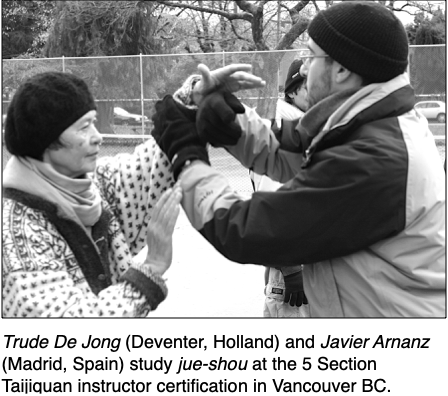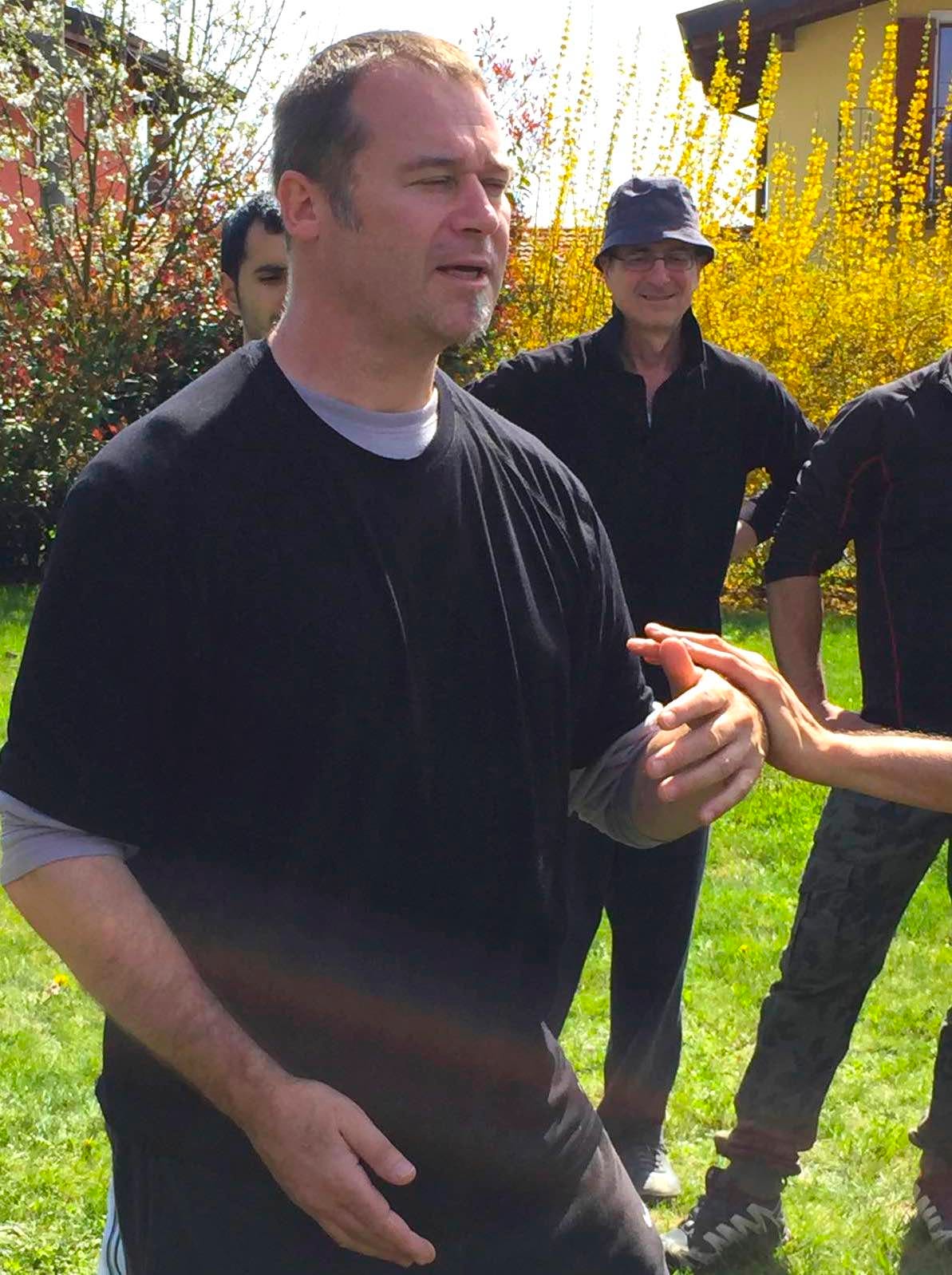An explanation and overview of ‘sensing-hands,’ one of the most important aspects of contemporary and traditional taijiquan partner training.
Jue-shou, or ‘sensing-hands,’ is a practice method for exploring the preliminary stages of taijiquan partner study. Through simple, non-competitive exploration, sensing-hands develops in practitioners tactile and kinesthetic ‘listening’ skills which enable them to discern and express different qualities of touch, force and intention. One result of jue-shou (覺手) practice is the development of ‘sticking’ and ‘adhering’ skills which lead to an ability to ‘comprehend energy’ for the purposes of self-cultivation and self-defence.
In the study of traditional taijiquan, students begin by learning solo routines and then move on to partner training exercises known as ‘push-hands’ (tui-shou 推手). Conventional push-hands studies employ a wide array of repetitive training drills in order to achieve mastery of what are known as ‘martial-kinetic energies’ (jin 勁). Command of these energies supports advanced martial-arts training. Oftentimes, however, in traditional training environments, the tedious early stages of skill acquisition are neglected in favour of more gratifying intricate or competitive play.
In 5 Section Taijiquan, these fundamentals are addressed through a unique preliminary-level curriculum which focuses on the early-stage ‘sensing’ (jue) elements of partner work. Sensing-hands practices may be introduced to students at any stage development, including at the outset of training. Consisting of five ‘martial-kinetic energies’ (jin) and supported by five ‘connection-operations,’ sensing-hands can aid practitioners in quickly gaining a deep understanding of the nature of the art.
The sensing-hands practice ‘free-binding’ is of great value in bridging the gap between solo and partner training as it clearly reveals principles which are often under-regarded in solo practice and assists one greatly in the mastery of the 5 Section paired bare-hand and straight-sword forms. Jue-shou practice provides an excellent foundation for traditional training and personal development through taijiquan.
The word jue absolutely brims with significance. It is comprised of two components, the topmost part originally having to do with ‘learning’ (𦥯 xue) and the bottom to do with seeing (見 jian). At a basic level jue means ‘to perceive,’ ‘to sense,’ or ‘to feel’ and can be used to refer directly to ‘feeling’ or ‘sensation’. It can also mean ‘to become aware’, ‘to become awakened,’ and ‘ to discover’.
The word jue figures in such ordinary phenomenon as spatial and auditory awareness, but is also a key component in notions such as ‘consciousness,’ ‘intuition,’ ‘enlightenment,’ and ‘realization’. Jue is employed in spiritual terminology such as ‘real-awakening’ (zhengjue 正覺), ‘ocean of enlightenment’ (juehai 覺海), and even 'ESP'—extrasensory perception (chaoganzhijue 超感知覺). Jue has also been used in describing nationalist and democratic ‘self-renewal movements’ (zijue yundong 自覺運動).
Zhijue yundong 知覺運動
In nineteenth-century taijiquan literature the term zhijue yundong (知覺運動) is used to describe the concept of ‘perceptual-movement’ which predicates both martial and spiritual progress and has to do with the dual processes of ‘sensation-through-mobilization’ and ‘awareness-through-movement.’ The similarity of zhijue yundong (perceptual-movement) and zijue yundong (social self-renewal movement) may well be reflective of the important tie between inner, self-cultivation practices (including via martial-arts) and social-transformation efforts; especially given the fact that these terms emerged during the same period and that martial artists were often connected with such progressive yet nationalistic movements. In fact, Yang Luchan, one of the most important early taijiquan figures, directly related the self-renewal and self-strengthening movements with taijiquan in his statement, “We are poor because we are weak. For a nation to rise, it must first strengthen its people.”
When we use ‘jue’ with the word ‘hand’, as in ‘jue-shou’, we imply something beyond a simple description of the practice. A ‘sensing hand’ is a useful and powerful thing. The hand that can listen, comprehend and receive can, through its contact with the world, effect healing, understanding, and nourishment of character. Its attentive outreach, its discerning touch, and its conscious clasp can allow the intercourse between world-and-self to be a constantly illuminating interchange.
A ‘sensing hand’ is a useful and powerful thing. The hand that can listen, comprehend and receive can, through its contact with the world, effect healing, understanding, and nourishment.
The word ‘jiao’ (攪), comprised of ‘hand’ (shou 扌—derived from 手) and ‘jue,’ offers yet another idea. This character means to ‘stir,’ ‘rouse,’ ‘agitate,’ ‘mix up,’ and even ‘annoy’. Here is a hand that gets involved, stirs things up, and rouses what is stagnant out of complacency. When such a hand is backed with consciousness and sensitivity it can arouse awakening, challenging lethargy and those assumptions which lead to moribund endings. A ‘sensing-hand’—a jue-shou—is one that touches the world, and in so doing, reaches toward awareness and enlightenment.
Five energies, two conditions, and five operations
Below is a list of the ‘five sensing-hands energies’ along with the ‘two conditions’ and the five ‘connection-operations’:
The first group, the ‘five sensing-hands energies’—‘listening energy’ (ting jin 聽勁), ‘comprehending energy’ (dong jin 懂勁), ‘receiving energy’ (zuo jin 走勁), and neutralizing energy’ (hua jin 化勁)—are progressive in nature, and have to do with the energetic interaction between the practicing partners through the ‘point-of-contact.’ These energies follow one upon the other in a step-by-step fashion, each providing the means for the next, making possible a deepening of the initial connection. They are also the first of a group of twenty-five energies found in traditional taijiquan.
The latter group of five inventories the mechanical operations—'rolling’ (gun 滚), ‘pivoting' (shu jin 樞), ‘transferring’ (qian jin 遷), ‘exchanging’ (huan 換), ‘inching’ (dian dian jin 點點)—that maintain of the point-of-contact. They are predicated on two qualities of connection, ‘resting-in’ (qixi 栖息) and ‘supporting’ (zhi 支) which create the condition for the operations to follow. The five operations that maintain the connection can be expressed independently or combine with one another as is appropriate to emerging circumstances.
One might think of the two groups of five in yin and yang terms, in the sense that the first has to do with energetics (yin) and the second with mechanics (yang). Like all things yin and yang, they compliment one another by way of their differences. The energetic quintet relies on the mechanical group for its expression, while the mechanical operations are given meaning by the energetic group. For example: It is not possible to ‘stick’ to the partner with consistency if the ‘rolling’ or ‘transferring’ are lacking in fluidity—yet it is not possible to achieve this fluidity without ‘listening’ and ‘comprehending.’
Sticking and adhering
If there is one quality that distinguishes taijiquan from almost all other activities, it is the art’s persistent return to the theme of ‘sticking-adhering energy’ (zhan-nian jin 粘黏勁). All taijiquan principles and practices, be they expressed through solo or partner work, be they barehand or with apparatus, relate in someway to sticking and adhering. This is what gives taijiquan its appearance and flavour and, ultimately, what defines the art in its essence.
Sticking-adhering energy is a sensitivity attribute employed by taijiquan practitioners skillful in maintaining a comfortable, even-pressured touch connection during changing conditions. These conditions could include: varied physical locations of the point-of-connection; differing tempos in movement; shifting intensities and intentions of participants, and even unpredictable self-defence situations. Utilizing this energy in taijiquan partner practices is generally referred to simply as ‘sticking.’
‘Sticking-adhering energy’ a sensitivity attribute employed by taijiquan practitioners skillful in maintaining a comfortable, even-pressured touch connection during changing conditions.
The ability to ‘stick’ diminishes the effects of unbalanced strength relationships and brings into one’s favour all manner of unforeseen advantages and opportunities. It ensures that one’s taijiquan journey will be abundant in opportunities for learning and gaining personal insight. Not only does sticking ability improve one’s ability with the 5 Section Taijiquan solo and partner forms, it also provides a foundation for studying all other types of traditional taijiquan.
The point-of-contact: resting-in & supporting
Sticking ability is based on one’s ability to securely make and maintain adherence to the exact location where physical connection takes place—the ‘point-of-contact.’ When performed well, this can be described as ‘deep sticking.’ If, however, the point is ‘chased,’ any sticking that results will be of a superficial nature; what might be described as ‘shallow sticking.’ Reflexive movement, such as that brought about by defensiveness or anticipation, makes it very difficult to maintain the point-of-contact with any degree reliability or presence of mind.
Deep sticking is a touch quality born from a sense of commitment-to-connection at and into the point-of-contact; yet it permits autonomy of action in the touched partner. Maintenance of this settled, yet motile joining—zhan-nian jin—allows the jue-shou practicer to avoid problems of the ‘four errors’ (sibing 四病) which are ‘reaching,’ ‘skewing,’ ‘losing,’ and ‘resisting’ (ding, pian, diu, kang 頂偏丟抗).
In order to accomplish sticking in this way, it is necessary to ‘rest-into’ the point-of-contact (when one is approaching connection with the partner) and to ‘support’ the point-of-contact (when being approached by the partner.) Resting-into and supporting the point-of-contact create the basic condition for maintaining the connection and, therefore, zhan-nian deep sticking. Whether one rests-in or supports usually depends on whether one is in the top or bottom position in the touch relationship: i.e. if one’s arm is atop the partner’s, one will rest-in; if one is below, it is more apt to support the partner.
Deftness with ‘resting-in and supporting’ operations provides the mechanical basis for zhan-nian deep sticking and opens the gateway for the five sensing-hands energies: ‘listening energy,’ ‘comprehending energy,’ ‘receiving energy,’ and neutralizing energy.’
Self-cultivation
There are some inherent technical challenges in the learning and practicing of jue-shou that must be explored and solved; however, obstacles to mastery are typically rooted in the individual’s own instinctive reactions, developed habits, and preference tendencies. Sensing-hands routinely confronts practitioners with their idiosyncrasies, limitations, and fears as these are revealed plainly in light of practice. It is this circumstance that is at the root of the art’s self-cultivation theory and which fosters a high degree of personal growth and individual expression in the art.
Jue-shou’s ultimate goal in terms of inner development is described in the nineteenth-century Taijiquan Treatise.
In mastering movement, one gradually acquires ‘comprehending energy.’ From the acquisition of dong jin, one can reach ‘spiritual illumination’ (shen ming 神明). Without long, persistent and arduous practice one cannot understand.
The promise here is; if, through sensing hands, one does the patient work of developing understanding—both of oneself and the other—the reward of inner and outer clarity will be forthcoming. Jue-shou then, is part of a path of self-cultivation rooted in inner and partner connection.
Although sensing-hands training is a formal part of The 5 Section Taijiquan Program it can be practiced in conjunction with traditional full-curriculum taijiquan training as well.
To learn more about the international 5 Section Taijiquan community the 5 Section Taijiquan International website.










Really appreciate the nuance here, a lot to think about and a lot to embody.